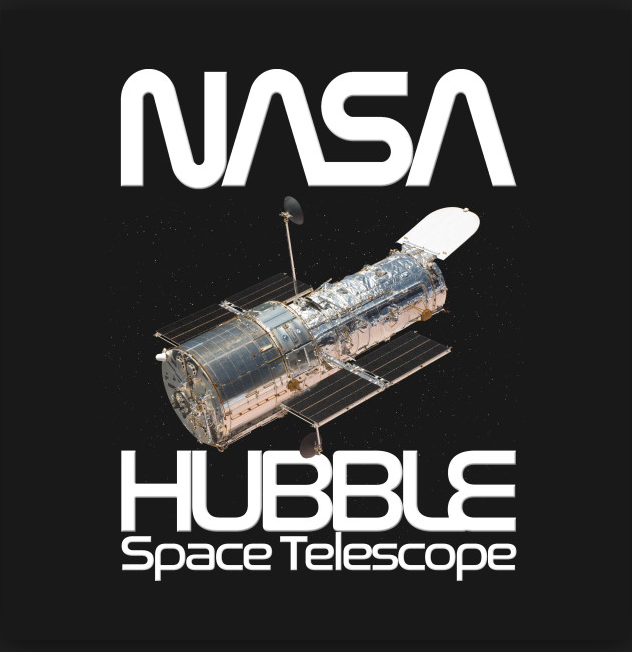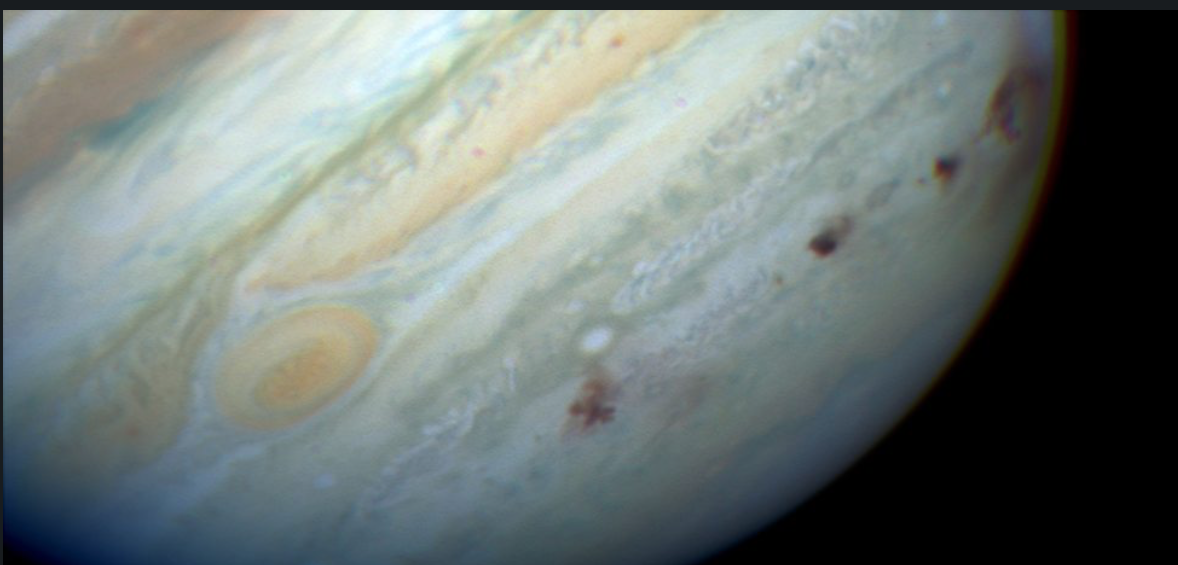
Introduction
During a previous close encounter with Jupiter a small comet fragmented. Due to the slightly different forces that the resulting components experienced, they assumed slightly different orbits and appeared to arrange themselves in a line of small comets that was discovered by Carolyn and Eugene Shoemaker and David Levy in 1993. They recognized it as a fragmented comet and, since this was the ninth comet this team had discovered, it was named Comet Shoemaker-Levy 9.
The fragments were scheduled to impact Jupiter on July 16-22,1994. Officials at HST Science Institute organized an imaging team, headed by Heidi Hammel, to observe the events. Their results are archived in this dataset.
The “scars” from the impacts were surprisingly large and dark. Unlike other dark features on Jupiter that fade as the feature rotates toward the limb - increasing the observer’s line of sight through the atmospheric hazes, these features increased in intensity, indicating they were located above the obscuring hazes in Jupiter’s atmosphere. It was proposed that the particles entered the atmosphere, heating the entry path and then exploding. Because the heating reduced the local density, the escape route was back the way they came, resulting in plumes that rose to 3000 km, indicating ejection speeds of 10km/sec. As the material fell back the heat of impact vaporized the material leaving behind carbon rich sooty material that would mark the circulation in the upper atmosphere. The Wide Field and Planetary Camera (WFPC2) with corrective optics to deal with spherical aberration in the telescope was used to image the comet impacts. Details of the camera are available in the WFPC2 Handbook.
Published estimates of the impact times and locations of the fragments of SL9 are given below (see Table 5 in Chodas, P.W. and Yeomans, D.K. IAU Colloquium 156',1996, eds. K.S. Noll, H.A. Weaver and P.D. Feldman (Cambridge and New York: Cambridge University Press). The impact was defined to occur at the 100 mbar level of Jupiter's atmosphere. The impact for all fragments except J and M are based on independent orbit solutions given by Chodas and Yeomans (1996). The estimates for the 'lost' fragments J and M were obtained by applying the tidal disruption model to the orbit for fragment Q1 and matching the astrometry of these two fragments relative to Q1. The third column of the table contains the final pre-impact prediction for each of the fragments The fourth column lists the final best estimates, which were inferred directly from impact phenomena for 16 fragments, and computed from the orbit solutions for the rest. All times are as viewed from the Earth, and therefore include the light travel time. The impact time uncertainties are rough estimates which indicate a confidence level in the accepted time; they are not formal 1-sigma uncertainties. The impact latitude is jovicentric, while the longitude is System III, measured westward on the planet. The meridian angle is the jovicentric longitude of the impact point measured from the midnight meridian towards the morning terminator. At the latitude of the impacts, the limb as viewed from the Earth is at meridian angle 76 deg, and the terminator is at meridian angle 87 deg. The final column gives the angular distance of the impacts behind the limb.
| Impact Time (UTC) | Impact Location | Meridian Angle | Angular Distance | |||||
|---|---|---|---|---|---|---|---|---|
| Fragment | Date | Predicted | Accepted | Lag | Lat. | Long | ||
| Behind Limb | ||||||||
| (July) | (h m s) | (h m s) | s | (deg) | (deg) | (deg) | (deg) | |
| A | 16 | 19:59:40 | 20:10:40 | 60 | -43.35 | 184 | 65.4 | 7.7 |
| B | 17 | 2:54:13 | 2:50:00 | 180 | -43.22 | 67 | 63.92 | 8.8 |
| C | 17 | 7:02:14 | 7:10:50 | 60 | -43.47 | 222 | 66.14 | 7.1 |
| D | 17 | 11:47:00 | 11:52:30 | 60 | -43.53 | 33 | 66.16 | 7.1 |
| E | 17 | 15:05:31 | 15:11:40 | 120 | -43.54 | 153 | 66.4 | 6.9 |
| F | 18 | 0:29:21 | 0:35:45 | 300 | -43.68 | 135 | 65.3 | 7.7 |
| G | 18 | 7:28:32 | 7:33:33 | 3 | -43.66 | 26 | 67.09 | 6.4 |
| H | 18 | 19:25:53 | 19:31:59 | 1 | -43.79 | 99 | 67.47 | 6.1 |
| J | 19 | 2:40 | 1:35 | 3600 | -43.75 | ~316 | 68.05 | ~6 |
| K | 19 | 10:18:32 | 10:24:17 | 2 | -43.86 | 278 | 68.32 | 5.5 |
| L | 19 | 22:08:53 | 22:16:49 | 1 | -43.96 | 348 | 68.86 | 5.1 |
| M | 20 | 5:45 | 6:00 | 600 | -43.93 | ~264 | 69.25 | ~5 |
| N | 20 | 10:20:02 | 10:29:20 | 2 | -44.31 | 71 | 68.68 | 5.1 |
| P2 | 20 | 15:16:20 | 15:21:11 | 300 | -44.69 | 249 | 67.58 | 5.8 |
| P1 | 20 | 16:30 | 16:32:35 | 800 | -45.02 | ~293 | 65.96 | 6.9 |
| Q2 | 20 | 19:47:11 | 19:44:00 | 60 | -44.32 | 46 | 69.26 | 4.7 |
| Q1 | 20 | 20:04:09 | 20:13:53 | 1 | -44 | 63 | 69.85 | 4.3 |
| R | 21 | 5:28:50 | 5:34:57 | 10 | -44.1 | 42 | 70.21 | 4.1 |
| S | 21 | 15:12:49 | 15:16:30 | 60 | -44.22 | 33 | 70.34 | 4 |
| T | 21 | 18:03:45 | 18:09:56 | 300 | -45.01 | 141 | 67.73 | 5.7 |
| U | 21 | 21:48:30 | 22:00:02 | 300 | -44.48 | 278 | 69.54 | 4.5 |
| V | 22 | 4:16:53 | 4:23:20 | 60 | -44.47 | 149 | 69.96 | 4.2 |
| W | 22 | 17:59:45 | 8:06:16 | 1 | -44.13 | 283 | 71.19 | 3.4 |
References:
Hammel HB1, Beebe RF, Ingersoll AP, Orton GS, Mills JR, Simon AA, Chodas P, Clarke JT, De Jong E, Dowling TE, et al., HST imaging of atmospheric phenomena created by the impact of comet Shoemaker-Levy 9., Science. 1995 Mar 3;267(5202):1288-96.
Objectives
To obtain high resolution multicolor imaging of the period spanning the impacts and their evolution.
Useful Mission Documents
Mission Description
Telescope Description HSTHOST
WFPC2 Description
WFPC2 Handbook
Data Set Description
References
Archived Datasets
This dataset consists of images of Jupiter taken by the Hubble Space Telescope (HST) during the Comet Shoemaker-Levy 9 (SL9) impact period, which occurred July 16-22, 1994. The impact data are supplemented by one multi-color rotation of the planet (6 orbits of data) on July 15 before any of the fragments impacted Jupiter's predawn hemisphere. A follow-up rotation was obtained Aug 24, a month after the last impacts to record the nature of dispersal of material.
The two modes of observation for WFPC2 are: the Wide Field mode (WF) with 0.1 arcseconds per pixel and the Planetary Camera mode (PC) with 0.043 arc sec per pixel. Images in each mode are formatted in 800 X 800 arrays of pixels. On 13 July 1994 Jupiter was 760,900,000 km from the earth. The apparent equatorial diameter spanned 38.82 arc seconds, or 903 pixels in the PC mode (PC1 Chip) and 388 in the WF mode (WF3 chip), yielding a spatial sampling rate equal to about 160 km in PC and 370 km in WF if the line of sight were perpendicular to the surface at the equator.
Characteristics of the selected filters are:
| Filter Name | Wavelength (nm) | Halfwidth (nm) | Pc (sec) | WF (sec) |
|---|---|---|---|---|
| F218W | 217 | 37 | ---- | 230,260 |
| F255W | 261 | 42 | 300 | 40,60 |
| F336W | 332 | 38 | 18 | 3,3.5 |
| F410M | 409 | 15 | 10 | 2,3 |
| F547M | 548 | 49 | ---- | 0.11,0.16 |
| F555W | 540 | 123 | 0.3 | ---- |
| FQCH4P15 | 888 | 15 | ---- | 4,10,4 |
| F953N | 953 | 7 | 16,35 | 8,16 |
Data Files - See Date Set Description for contents.
The data are in FITS format with detached labels
volume sl9_0005 contains data from 7/15, 716, 7/17, 7/18, 7/19, 7/20 and 7/21
volume sl9_0006 contains data from 7/21, 7/22, 7/23, 7/30 and 8/24.
volume sl9_0006 contains data from 7/21, 7/22, 7/23, 7/30 and 8/24.
Citing Data
Other Useful Products for Interpreting the Data
Literature Search - using the Astrophysics Data System (ADS) and searching on author (see. Reference above) and Shoemaker-Levy in the abstract should yield additional references.
 PDS: The Planetary Atmospheres Node
PDS: The Planetary Atmospheres Node


